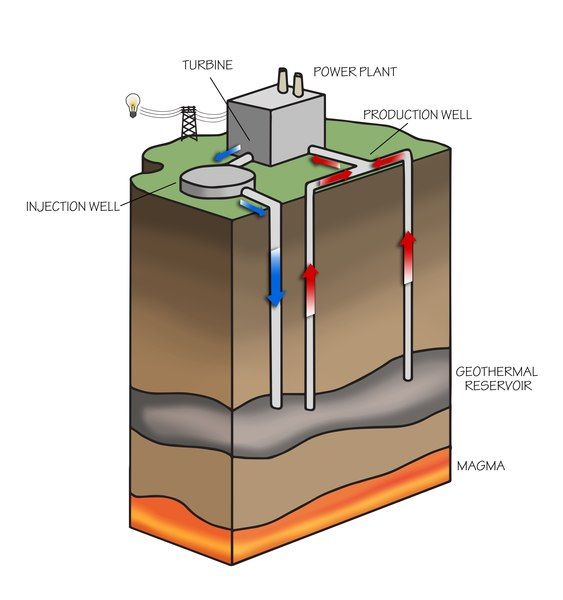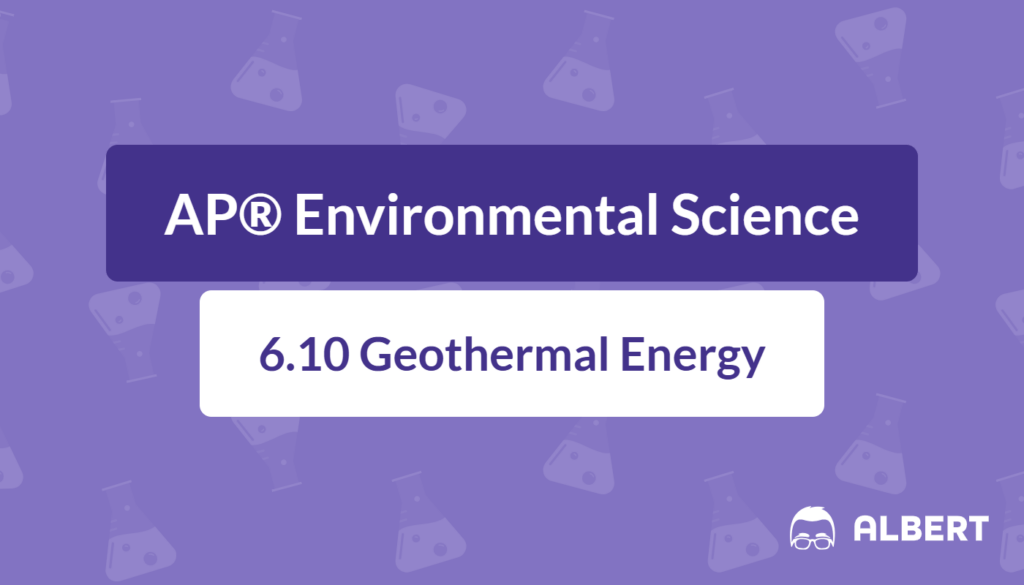What We Review
Introduction
Geothermal energy is the thermal energy present inside Earth, which can be harnessed to produce electricity and meet other heating needs. Unlike fossil fuels, geothermal energy relies on Earth’s internal heat rather than combustible materials. Significantly, this form of energy is considered renewable because the processes that generate heat beneath the Earth’s surface continue over extremely long timescales. Although geothermal energy is not accessed as widely as solar or wind, it is an important resource for regions where underground heat reservoirs are within reach, helping to answer the question of what is geothermal power.
Studying geothermal energy is valuable for understanding diverse approaches to power generation. Because geothermal resources are available in many volcanic or tectonically active areas, regional differences in geology can affect how easily these resources are accessed. Nevertheless, scientists and engineers continue to develop techniques for using heat from within Earth more safely and effectively. Therefore, geothermal energy represents an intriguing and potentially impactful component of the overall energy landscape.
What Is Geothermal Power?
Geothermal power refers specifically to the process of converting Earth’s internal heat into electricity. This is typically accomplished by extracting hot water and steam from underground reservoirs to turn turbines connected to electric generators. The turbines spin rapidly when driven by steam, which then generates electricity. Overall, geothermal power plants rely on heat naturally stored in rock formations or water reservoirs deep beneath the ground.
Because this process continues to function as long as there is a consistent source of heat, geothermal power exhibits strong reliability compared to certain intermittent resources, such as solar or wind. However, it does require that hot water be present at temperatures high enough to produce steam. Consequently, geothermal plants are often located in areas noted for their thermal activity, including places near volcanic regions or tectonic plate boundaries.
Step-by-Step Breakdown of Geothermal Power Generation
Below is a simplified description of how geothermal energy is used to generate electricity:
- Exploration and Drilling
- Engineers identify regions with geothermal potential, typically by analyzing geological data.
- Wells are drilled to reach the hot water and steam reservoirs.
- Extraction of Hot Water and Steam
- Water heated by rocks inside Earth is pumped to the surface.
- Once at ground level, the heated mix is directed into a separator, which isolates high-pressure steam.
- Steam Drives a Turbine
- The steam spins a turbine’s blades.
- A generator attached to the turbine converts the mechanical energy into electricity.
- Cooling and Re‑injection
- Next, used steam is cooled back into water.
- Finally, this water is often re-injected into Earth’s aquifers to maintain the reservoir and sustain the process.
Example: A Small Geothermal Power Plant
Consider a modest geothermal power plant located near a volcanic region. First, geologists discover high-temperature underground water reaching above 150^\circ \text{C}. Then, drilling teams install production wells to bring hot fluid to the surface. After separation of steam from water, the steam passes into a turbine, generating enough electricity to power nearby communities. The leftover water is cooled and re-injected into reservoir zones below ground. Because the geothermal source is continuously replenished by Earth’s heat, the power plant experiences fewer shutdowns compared to those that depend on fluctuating weather conditions.

How Is Geothermal Energy Used?
Geothermal energy is versatile and not limited to power plant operations. In some cases, it directly supplies heat:
- Heating Buildings: Homes, offices, and greenhouses can tap into geothermal heat to reduce reliance on conventional heating. This is especially true in regions with naturally warmed groundwater close to the surface.
- Agricultural Applications: Geothermal energy supports more efficient greenhouse cultivation. Warmth from underground water reduces the need for fossil fuels in regulating greenhouse temperatures.
- Industrial Processes: Certain manufacturing steps require consistent heat. Therefore, factories in locations with geothermal reservoirs can use this energy for processing or drying materials.
Accordingly, the specific method chosen depends on local geology. Regions rich in thermal resources are more likely to construct geothermal power plants, while areas with mild geothermal activity may only engage in direct heating applications. Nevertheless, both approaches contribute to reducing dependency on nonrenewable energy sources.
Comparison with Traditional Power Plants
Traditional fossil-fuel power plants burn coal, oil, or natural gas, generating steam to spin a turbine. By contrast, a geothermal power plant relies on naturally heated water below ground. Consequently, geothermal plants typically have lower greenhouse gas emissions. However, building geothermal facilities can be expensive and is only viable in locations where geologic conditions are favorable. In contrast, fossil-fuel plants can be constructed in many places but continue to emit large amounts of carbon dioxide. Therefore, the choice of electricity source often hinges on balancing environmental impacts, access to resources, and financial considerations.
Environmental Effects of Geothermal Energy
Geothermal energy exhibits several environmental advantages but also poses some drawbacks. It is a renewable energy source that relies on Earth’s continuous internal heat, which does not deplete in the same way fossil fuels do. Moreover, greenhouse gas emissions from geothermal plants are significantly lower than from coal-fired or natural gas power stations. Thus, geothermal energy can help reduce overall carbon dioxide releases. Because of that, it is sometimes promoted as an important option for aiding climate change mitigation.
Nevertheless, there are potential environmental impacts. For example, geothermal plants sometimes release hydrogen sulfide, which has a recognizable “rotten egg” odor. Although hydrogen sulfide is typically released in small quantities, it must be monitored and managed. Additionally, drilling into geothermal reservoirs can be expensive and may involve large infrastructure. This process raises concerns related to surface land use, maintenance of equipment in harsh environments, and the possibility of minor seismic activities in tectonically sensitive regions.
Advantages
- Renewable and sustainable source of power
- Low emissions of greenhouse gases
- Reliable electricity production independent of weather
Disadvantages
- High upfront costs for exploration and plant construction
- Release of hydrogen sulfide (H₂S) and other gases
- Limited to regions with accessible geothermal resources
Overall, geothermal energy ranks well among low-carbon technologies. However, it is not suitable everywhere. Because many geological variables affect the feasibility of drilling and delivering steam, experts must conduct thorough feasibility studies before proceeding with a project.
Challenges in Geothermal Energy Development
Although geothermal energy is promising, it faces several challenges:
- Geographic Limitations
- Not all regions are rich in geothermal reservoirs.
- Consequently, locations near tectonic plate boundaries or volcanic regions benefit most.
- Economic Factors
- Drilling, exploration, and plant construction have high upfront costs.
- Operators must balance these investments with the long-term revenue from electricity sales.
- Resource Management
- Over-extraction of hot water could cool the reservoir sooner than expected if not managed carefully.
- Therefore, re-injection programs help sustain reservoir pressure and temperature.
Because of these challenges, some countries prioritize more easily deployed renewable favorites, such as wind or solar. Nonetheless, interest in geothermal power persists, especially in places like Iceland, the Philippines, and parts of the United States. As technology advances and drilling methods become more refined, geothermal power may become more accessible in areas that once seemed impractical.
Future of Geothermal Energy
Innovations in drilling technology and resource exploration are expanding the reach of geothermal systems. Some researchers are investigating enhanced geothermal systems, which involve artificially fracturing rock formations. This makes it possible to extract heat from areas without naturally abundant steam.
Additionally, rising concerns about climate change encourage governments and private investors to consider diverse renewable energy portfolios. As the cost of geothermal technology decreases, more communities may turn to this stable source of baseload power. Therefore, geothermal energy could become a pivotal part of global energy strategies, reducing reliance on fossil fuels while supporting economic development.
Because geothermal systems offer consistent output, they can complement variable renewables like solar and wind. For instance, a geothermal plant might operate around the clock, while solar farms operate mainly during daylight. Altogether, a diversified renewable energy grid can harness multiple power sources, thereby ensuring a stable and sustainable supply of electricity worldwide.
Conclusion
Geothermal energy harnesses Earth’s internal heat to produce electricity and supply direct thermal applications. In many respects, it offers a clean, renewable alternative to fossil fuels. By tapping into underground reservoirs of hot water and steam, communities can generate reliable power while emitting fewer greenhouse gases. However, geographic limitations and high initial costs remain major obstacles. Moreover, geothermal activities may release hydrogen sulfide, requiring proper environmental safeguards and monitoring.
Despite these challenges, geothermal energy continues to evolve with innovative drilling methods and advancements in reservoir management. As governments seek lower-carbon options, this reliable resource could play a more significant role in reducing dependency on fossil fuels. Understanding geothermal energy is essential, as it highlights the intersection of geology, engineering, and sustainability.
Important Vocabulary
- Geothermal Energy: Heat derived from Earth’s interior, used to produce electricity or provide direct heating.
- Steam: The gaseous form of water generated when liquid water is heated above its boiling point.
- Hydrogen Sulfide: A foul-smelling gas often released in small quantities by geothermal plants, characterized by its “rotten egg” odor.
- Renewable Energy: Energy sourced from processes that are continually replenished, such as geothermal heat, solar radiation, or wind.
- Power Generation: The process of producing electric power from energy sources like geothermal, fossil fuels, or solar radiation.
Sharpen Your Skills for AP® Environmental Science
Are you preparing for the AP® Environmental Science test? We’ve got you covered! Try our review articles designed to help you confidently tackle real-world AP® Environmental Science problems. You’ll find everything you need to succeed, from quick tips to detailed strategies. Start exploring now!
- AP® Environmental Science: 6.7 Review
- AP® Environmental Science: 6.8 Review
- AP® Environmental Science: 6.9 Review
Need help preparing for your AP® Environmental Science exam?
Albert has hundreds of AP® Environmental Science practice questions, free response, and full-length practice tests to try out.








